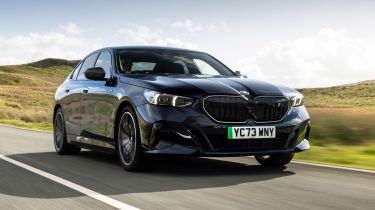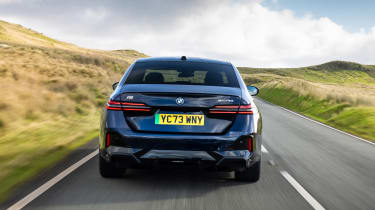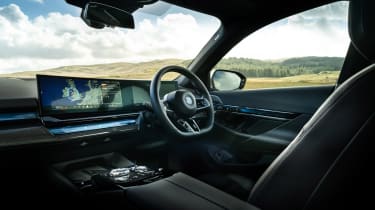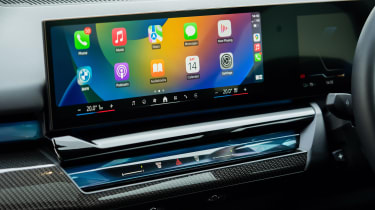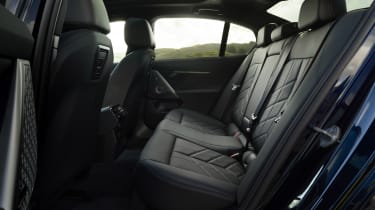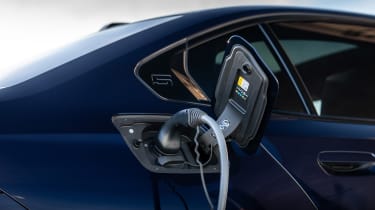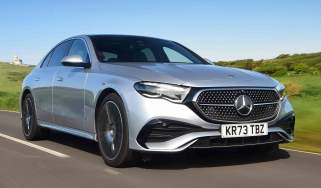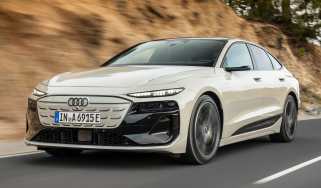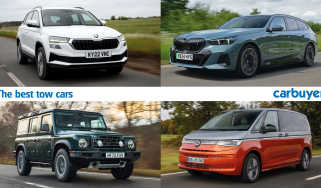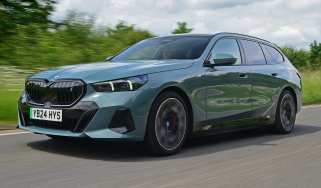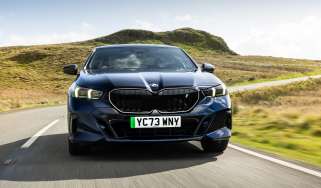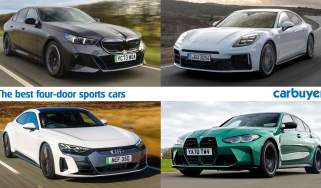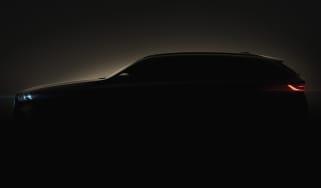BMW i5 review - refined and good to drive
"The BMW i5 is refined and good to drive, making it one of the most well-rounded electric saloon cars currently on sale"
Pros
- Good to drive
- Refined
- Impressive infotainment
Cons
- Not as fun as the petrol 5 Series
- Middling range
- Tesla Model S is more practical
Verdict – is the BMW i5 a good car?
The BMW i5 may just be the most well-rounded electric executive car currently on sale, and should be capable of convincing loyal customers of the conventional 5 Series that it's one of the best electric cars. It’s comfortable, quiet, offers excellent infotainment tech and while a petrol 5 Series is better to drive, it’s enjoyable on twisty roads too. Overall, though, the BMW i5 is a great choice if you’re in the market for an electric executive saloon.
BMW i5 models, specs and alternatives
The BMW i5 is the first electric version of the BMW 5 Series, now in its eighth generation, and itself offered in petrol and plug-in hybrid guise. The i5 sets its aim squarely on rivals such as the Tesla Model S, Porsche Taycan, Mercedes EQE and Audi e-tron GT.
Whereas the appeal of other electric models lies in their fresh approach, the BMW i5 appeals by having a familiar look to the 5 Series, helping to cement the lineage of the model for an electric future.
The BMW i5’s lineup is fairly simple; buyers can choose between the entry-level rear-wheel drive eDrive40 model and the four-wheel drive M60 xDrive M Performance. We’d expect the former to be a bigger seller given that it’s much more affordable and acts as a logical stepping stone for buyers going from a conventional petrol-powered 5 Series to something electric. It’s also the most compelling version of the 5 Series for company car choosers, as its zero-emissions credentials put it in a very low Benefit-in-Kind (BiK) tax bracket.
 Top 10 best executive cars 2025
Top 10 best executive cars 2025
At the time of writing, the i5 now costs from around £68,000; quite a bit less than its original launch price of £74,000. That’s because it originally launched in the sporty and higher-spec M Sport trim, but can now be had in subtler Sport Edition guise. It’s still an expensive car, of course, but that now puts it at a lower price than the Mercedes EQE – we think the i5 is the better car, though, so that makes it look competitive.
More reviews
In-depth reviews
Sport Edition gets chrome exterior trim and 19-inch alloy wheels, as well as LED headlights, faux leather interior upholstery, wireless smartphone charging, dual-zone climate control, a rear-view parking camera and more, so it’s hardly spartan. There are plenty of reasons you might go for the M Sport model above this, though, but the biggest might be because its sportier styling does give it more road presence – if you can do without that you might be better off sticking to Sport Edition.
There’s also a higher-performance four-wheel drive i5 M60 xDrive M Performance model, which aside from a significant power bump, also gains an adaptive suspension setup and some extra black exterior trim to give it a sportier look.
| Trim levels | Power options |
|
|
BMW i5 alternatives
While the i5 is the first electric BMW 5 Series, it’s certainly not alone in the growing electric executive saloon segment. Its direct rivals include the Porsche Taycan, Tesla Model S and Mercedes EQE, but it will also be vying to tempt buyers away from the upcoming electric version of the next Audi A6. The BMW i5 also has to contend with a growing number of practical electric executive SUVs like the Audi Q8 e-tron and its own BMW iX model.
Electric executive saloons
- Porsche Taycan
- Tesla Model S
- Mercedes EQE
- Audi A6 e-tron
Large electric SUVs
Range, charging & running costs
The BMW i5 is an expensive car to buy, but its zero-tailpipe emissions mean it will sit in the lowest BiK (Benefit-in-Kind) tax bracket, so it’ll be the cheapest version of the 5 Series to run for company car buyers.
While electricity is cheaper than petrol, home rates at the time of writing are about 30p/kWh, meaning that a full charge of the i5’s battery pack will cost around £20 via a home charger, or around £55 at a public rapid charger.
BMW has worked hard to make the i5 as aerodynamic as possible, with tricks such as a movable flap on the grille to only let air in for cooling when needed, which the brand says improves range by 16 miles. The standard 20-inch wheels also get special inserts which can add six miles to the range. Despite this, the i5’s range is adequate, rather than class-leading, but the 362-mile figure in entry-level eDrive40 models should be enough if you’re used to a conventionally-fuelled car.
In comparison, the Mercedes EQE gets an official figure of 376 miles, and the Tesla Model S will go even further at up to 405 miles to a charge. The i5 does beat the Porsche Taycan’s range figure of up to 315 miles, however.
When it comes to charging up the i5, its 7kW home wallbox charging speed capability means it will take around 13 hours to go from 10 to 80%. The good news is that the i5 can accept DC ultra-rapid public charging at a rate of up to 205kW, so a 10 to 80% recharge will take just half an hour at a compatible chargepoint. The car also benefits from a feature that will pre-condition the battery for faster charging if it sees you have set your waypoint to a charger via the sat-nav.
| Model | Battery size | Range |
| BMW i5 eDrive40 | 84kWh | 362 miles |
| BMW i5 M60 xDrive | 84kWh | 320 miles |
Insurance
The BMW i5 starts in insurance group 43 out of 50 for the Sport Edition or M Sport with the base motor setup. Upgrade to the full-fat M60 xDrive and the insurance group rises to 49 out of 50. That means it will be expensive to insure, but surprisingly not quite as expensive as the Mercedes EQE, all the trim levels of which sit in the highest group 50.
Electric motor, drive & performance
The BMW i5 does a good job at inspiring confidence in its driver. The eDrive40 is now available in base-model Sport Edition trim, but going for M Sport or M Sport Pro trims, you’ll get suspension that’s 8mm lower for a sportier feel. The ride is on the firm side, but it’s still comfortable, and the suspension does a great job of keeping body movements in check. Grip levels are enormous and the steering feels light yet accurate, if not as involving as existing BMW customers will be used to. Ultimately, the weight of the battery means it doesn’t feel as agile as other versions of the 5 Series, but compared to a Mercedes EQE, it’s streets ahead. The powertrain in the eDrive40 sends 335bhp to the rear wheels, and for most buyers, the smooth, brisk acceleration will be more than enough.
For even sprightlier performance, though, there’s the M60 xDrive, which has 592bhp and four-wheel drive thanks to an extra motor on the front axle. This model feels devastatingly quick, while the four-wheel drive configuration means it has lots of traction and grip. Again, though, while it’s good to drive and feels balanced enough, the extra weight of the batteries is noticeable compared to the 5 Series.
The M60 also gets an upgraded adaptive suspension that can be firmed up or softened off as required. The sportier modes preserve the Beemer’s impressive level of control, while the cushier modes make the ride much more pleasant. Four-wheel steering is also included to give a tighter turning circle at low speed, along with greater high-speed stability, and it’s very effective. This setup can be added as an option to the eDrive40, and it’s definitely one worth considering, if only for the improved comfort it delivers. On the M60, there’s an additional optional version of the active suspension that adds Active Roll Stabilisation, and this also helps towards an increased level of agility.
The BMW i5 comes with four-wheel steering which is very useful in tighter situations for improved manoeuvrability around town, but occasionally during cornering at low speeds the rear axle takes a little longer to respond than the front, which slightly mars the feeling of precision.
0-62mph and top speed
There’s lots of power on offer in both the standard i5 and the M60 version, and neither model feels particularly slow. The rear-wheel drive eDrive40 gets a top speed of 119mph and a 0-62mph time of six seconds, which should be adequate for most drivers. Of course, the performance-focused M60’s power increase and four-wheel drive setup means it accelerates much quicker, with a 0-62mph time of just 3.8 seconds and a top speed of 142mph.
| Model | Power | 0-62mph | Top speed |
| eDrive40 | 335bhp | 6s | 119mph |
| M60 xDrive | 592bhp | 3.8s | 142mph |
Interior & comfort
Rather than the ultra-minimalist interior design of the Tesla Model S, or the slightly busier, but classic layout of the Porsche Taycan, the BMW i5 sits somewhere in between; a pleasing blend of modern minimalism and good ergonomics and build quality. Instead of a single, tablet-style central display, you get BMW’s curved, dual-screen setup which integrates both the 14.9-inch infotainment touchscreen and 12.3-inch digital dials into one sleek unit.
The BMW i5’s interior looks upmarket and makes use of high-quality materials. Customers get a choice of a black Alcantara, or multiple faux leather materials coming in either Burgundy, Espresso Brown, Smoke White or black colours at no extra cost. Otherwise, you can pay extra for one of BMW’s ‘Individual’ leather options for £2,100, which come in a variety of colours. As standard the i5 gets dark silver metallic-looking trim, but buyers can pay extra for one of three slightly classy wood materials.
The dashboard gets an overall cleaner design than that of previous 5 Series generations, but gets hi-tech touches such as a sleek touch-sensitive ‘Interaction Bar’ which seamlessly blends in with the ambient lighting and allows the user to change settings such as ventilation, climate control and open the glove box – the colour changes depending on the action you perform, adding a touch of theatre to the user experience, and making the car feel futuristic.
It’s not perfect, however – for example, we’re not a fan of the chintzy crystal finish used on the gear selector, and the red band at the top of the rim of our test model’s steering wheel looked a little out of place, but these are minor gripes.
Infotainment and navigation
The curved infotainment screen features a new Quick Select menu function that allows you to configure shortcuts to different system features, which makes it easier and quicker to use and stops you needing to navigate through multiple tedious sub-menus. The BMW i5’s infotainment is the brand’s easiest-to-use and fastest system to date.
Features include the optional BMW Live Cockpit Professional – it’s a hi-tech heads-up display that projects important information onto the windscreen to help with navigation. There’s also the brand’s Digital Key Plus technology, which turns your Apple or Android smartphone and up to five other people’s into a key which not only unlocks the car, but also adjusts the interior settings for each user. The app even allows the driver to park their BMW from outside via the Remote Control Parking feature.
Equipment
From launch, the BMW i5 was offered from M Sport specification in the UK. Now, BMW has introduced the Sport Edition which sits below it for a more affordable starting price. This still gets 19-inch alloys, adaptive LED headlights, ambient interior lighting, heated front seats, wireless smartphone charging, a Harman Kardon sound system and more. The main difference is that it gets subtler, less sporty styling compared with the M Sport cars, and forgoes the M Sport suspension setup – that comfort-focused approach might be part of the attraction for some buyers.
Practicality & boot space
At over five metres long, the BMW i5 is a large car indeed, but that has translated to an excellent amount of interior space. There’s plenty of legroom in the back for passengers and there’s a generous amount of headroom, too, with or without the optional panoramic sunroof. If we were to criticise anything it would be the limited storage space in the door pockets, which aren’t terribly big.
USB-C ports integrated into the front seat backs are only included as part of a £1,700 comfort pack, which seems a little bit much in what is an already expensive car.
| Size comparison | |||
| Model | Length | Width | Height |
| BMW i5 | 5,060mm | 1,900mm | 1,515mm |
| Mercedes EQE | 4,946mm | 1,906mm | 1,503mm |
| Tesla Model S | 4,970mm | 1,964mm | 1445mm |
| Porsche Taycan | 4,963mm | 1,966mm | 1,395mm |
Boot space
The BMW i5 has a 490-litre boot, which is a little larger than the 430-litre space in the Mercedes EQE, although we’re yet to find out how they compare with the seats folded down. Unfortunately, though, you don’t get a ‘frunk’ in the BMW i5 like you do with some rivals, but there is at least a storage well under the boot for storing the charging cables. For outright practicality, the i5 saloon is no match for the Tesla Model S, with its hatchback bodystyle and 150-litre frunk that results in a total of 894 litres of storage space with the seats up. As is common on many modern cars, you can option the BMW i5 with a powered tailgate as part of the ‘Comfort Pack’.
| Boot space comparison | |
| Model | Boot space |
| BMW i5 | 460 litres |
| Mercedes EQE | 430 litres |
| Tesla Model S | 745 litres (894 litres including frunk) |
| Porsche Taycan | 366 litres (447 litres including frunk) |
Reliability & safety
The BMW i5 and latest 5 Series have not yet been out long enough to get a good idea of how they perform in terms of customer satisfaction and reliability. BMW as a brand, however, came in 14th place out of 32 manufacturers in the 2024 Driver Power customer satisfaction survey, which is a big improvement on its 21st-place finish the year before. That’s ahead of its rival brands Mercedes (25th) and Audi (27th).
BMW owners like the powertrains and driving feel of their cars compared with most other manufacturers, and while around 21% of BMW owners reported an issue with their car in the first year of ownership, 26% of Mercedes owners reported at issue and a shocking 38% of Tesla owners reported an issue with their cars in the first year. While these BMW statistics aren’t unique to just the electric models, we’re yet to hear of any major horror stories.
Safety
The BMW i5 was crash-tested by Euro NCAP in December 2023, receiving the full five-star rating. It excelled in almost every area, with results in the high 80s for adult, child occupant and vulnerable road user protection. It achieves 78% in the safety assist category.
The BMW i5 gets a generous amount of safety kit as standard including autonomous emergency braking, lane-keep assist, blind-spot monitoring, and a reversing camera, and the ‘Professional’ pack adds a 360-degree camera and semi-autonomous driving tech.
Which Is Best?
Cheapest
- Name250kW eDrive40 Sport Edition 84kWh 4dr Auto
- Gearbox typeAuto
- RRP£68,285
Most Economical
- Name250kW eDrive40 Sport Edition 84kWh 4dr Auto [Tec+]
- Gearbox typeAuto
- RRP£72,605
Fastest
- Name442kW M60 xDrive 84kWh 4dr Auto
- Gearbox typeAuto
- RRP£98,335
